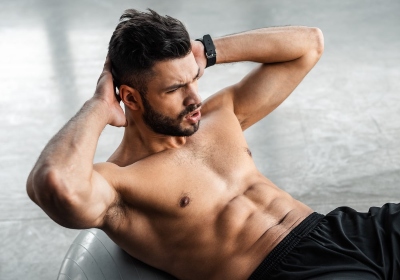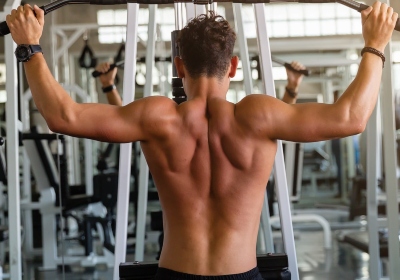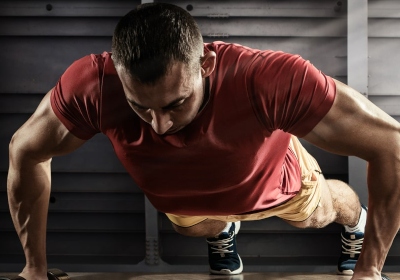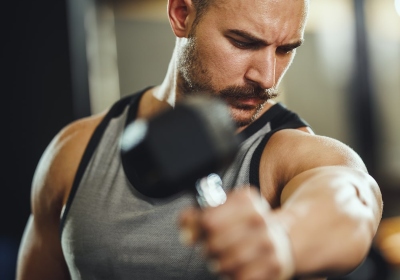VIDEO
Dumbbell Snatch
- Abs
- Wrists
- Biceps
- Triceps
- Upper Back
- Lower Back
- Shoulders
- Gluteus
- Quads
- Hamstrings
- Thighs
- Chest
Level:Advanced
Trainer:Nick Taylor
Equipment:Dumbbell
Dumbbell Snatch
- Abs
- Wrists
- Biceps
- Triceps
- Upper Back
- Lower Back
- Shoulders
- Gluteus
- Quads
- Hamstrings
- Thighs
- Chest
Level:Advanced
Trainer:Nick Taylor
Equipment:Dumbbell
This is a powerful exercise that is going target your Lower Back, legs, and shoulder stability as well. Stand straight with your feet slightly wider than shoulder-width apart. Squat down, grab the dumbbel in your hand, making sure that your feet are glued to the ground. And keeping your back straight, explode up, lifting the dumbbell above your head. Remember that you need to stay tall, and your back should be straight throughout the movement.
save to ...
RECOMMENDED FOR YOU
- Biceps
- Gluteus
- Hamstrings
Duaration: 00:49
save to playlist
ARTICLES
Since ancient times, developed muscles have been one of the hallmarks of a harmoniously developed, athletic body. There is no such thing as 'abs' in anatomy. This is a conditional abdominal muscle. There are four of them:
rectus;
internal oblique;
external oblique and transversus.
The rectus abdominis muscle is the largest in area. It’s a popular fallacy that there is a 'lower' and 'upper' press, but the rectus muscle does not have such a division. The notorious 'six-pack' stands out because of the tendon bridges on the rectus abdominis muscle. The muscle bundles of the external abdominal muscle begin from the lower eight ribs and extend radially downward. The transverse muscle is located deeper than the other abdominal muscles. In this case, the tendon extension in the upper two-thirds passes behind the rectus muscle, and in the lower third - in front. Partly because of this, the lower abs are less workable than the upper ones. The abdominal muscles are referred to as the core muscles, the muscle complex responsible for stabilizing the spine, pelvis, and hips. Each of the abdominal muscles is responsible for its own functions. One of the most common fallacies in abdominal training is that the more reps we do in a set, the stronger and bigger the abs will be. In fact, the muscles of the abs are no different in terms of training from the biceps. To increase the biceps, you will do one hundred reps per set. However, you will reduce the number of sets and reps, but increase the load. By increasing the number of repetitions in the set, you will develop strength endurance, but the muscle will not get thicker from this. It is much more effective to increase the load, do sets with weights and reduce the number of repetitions in the set. Three factors affect the appearance of your abs: posture, body fat percentage, and muscle development.
Posture.If a person pumps muscles but slouches, and he has excess fat, then the abs will not be visible. If a person does not pump the abs, but he has a good posture and a small percentage of body fat, then his belly will look flatter. That is why it makes no sense to start with the question of how to properly pump the abs. You need to start by working on your posture. The good news is that your core muscles are also responsible for correct posture. And they are usually used in workouts with an emphasis on the abs.
Fat percentage.Measuring body composition on an analyzer scale will show the percentage of body fat, which explains why the abs are invisible. If the fat is more than 15-20%, then it’s hard to see your six-pack. At 15% or less, the abs begin to be seen. 8% is abs athletes have. But do not try to completely get rid of fat for beautiful abs. Fat is necessary for the proper functioning of the endocrine system and other processes in the body. To achieve tangible results, it is important to monitor the factors that affect the percentage of body fat like food, sleep, stress levels, and the amount of daily physical activity.
Muscle development.You mustn’t focus only on abs exercises, you need to develop the body complexly and do a variety of activities. Strength training will strengthen your muscles, burn calories and build endurance with interval training. Recovery activities help with posture, flexibility, and muscle balance. The optimal training program can be selected after fitness testing, which takes into account how a person moves, what restrictions he has.
Read more
The most important muscles in the upper back are the lats and trapezius.
Lats (Latissimus dorsi). Shaping muscles of the back, giving the figure a tapered appearance. Visually widen the shoulders and make the waist appear narrower. They are located on both sides of the spine, and their shape resembles a wing.
Trapezius muscles. These are the muscles that need to be trained if you want to correct the slouch. Responsible for the movement of the scapula. They have a triangular shape; in the upper part, they are attached to the back of the head, in the lower part - to the spine.
Be careful, ‘cos back exercises are some of the most traumatic. In the early stages, use light weights to strengthen the ligaments and muscles to protect the spine. After mastering the technique, gradually and very gently increase the weight.
The upper and horizontal rows are the exercises closest to the anatomical movement of the joints.
Training
Wide grip pull-ups. Pulling up is one of the main exercises for back muscle growth, performed with body weight. First, learn how to pull up correctly, and only then move on to training with dumbbells or a barbell. It is important that when performing the exercise, you should feel the work of the back muscles, not the biceps. Grab the horizontal bar with an upper grip, arms slightly wider than shoulder-width. When pulling up, try to pull the body up not with your hands, but with your back. Pause for a second at the top point, smoothly return to the starting position.
Upper block thrust. The exercise imitates pulling up, go to it only when you learn to pull up, and you can do it at least 8-10 times per set. Important: pulling the bar towards your chest, not your head - this will reduce the dangerous load on your shoulders, a signal of improper performance - to feel the work of the hands. If you can't feel your back, use less weight. increase the width of the grip every time - this has a positive effect on the 'growth' of the back.
Seated pulldown. A basic exercise that includes a large muscle mass, especially the pectorals and lats. One of the best for giving the back a visual width. With a straight bar (see photo), the trapezius muscles are also included in the work.
Make sure that the cable is parallel to the floor during the exercise, the torso does not change the slope, and the back is straight.
Shrugs. Almost the only exercise for isolated work on the trapezius muscles. There are many variations - with dumbbells, with a barbell, standing, sitting or lying down. The photo shows an option sitting on a bench with dumbbells.
When lifting the dumbbells up, you can lower your chin slightly, which will increase the load on the muscles. It is important not to rotate your shoulders or relax them at the bottom of the exercise - this is very dangerous for the joints.
One-arm dumbbell row. Place your knee and hand on the bench. Take the dumbbell with your other hand, pull it as close to your chest as possible, then slowly lower it down. Make sure that your back is parallel to the floor during the exercise, do not round it; do not drop your non-working shoulder.
Important:
As soon as the elbow is at shoulder level, connect the shoulder to the movement - pull it up with the elbow. This will maximize the contraction of your mid-back and upper lats.
If you are having trouble getting your elbow higher than your shoulder, use a lighter dumbbell.
Read more
Push-ups, strength exercises, gymnastic elements on rings and a horizontal bar, handstand - all these exercises require strong and flexible wrists. Let’s discuss how to develop your wrist strength and do exercises without pain and discomfort.
The wrist is a movable connection of the bones of the forearm and hand of a person. It is formed by the extended and concave carpal articular surface of the radius and a medially located triangular cartilaginous disc, representing a concave articular surface articulating with the convex proximal (located closer to the body) articular surface of the bones of the first row of the wrist: scaphoid, lunate and trihedral.
The proximal row is connected with the exchange cyst behind the additional exchange wrist joint. The skin row is set in an arch, bent proximally and distally bent. On the long sides of the wrists of the vignutia set up the carpal canal, we will fix the flexor retinaculum. The proximal row is connected with the surfaces of the exchange brush and the distal row. In the proximal row, the dermal cyst can be surrounded by an undisclosed ruffle: for example, it is more like the fate of the unprotected midget steel, which can be easily joined from the trapezoidal and trapezoidal style. The cysts of the distal row, on the other hand, are more rigidly fastened, so that the whole row collapses at once with the pastoral cysts.
Some sports require strong wrists. Wrist strength should be developed in parallel with flexibility. This will help you do exercises that require not only good grip but also joint mobility. Exercises for the wrists are also useful for people who are far from sports. Warming up and stretching the wrists can help avoid tunnel syndrome - the compression of the median nerve between the bones and tendons of the wrist. Warming up will help relieve tension and will be excellent pain prevention.
The number of eight wrist cysts can be divided into two transverse rows (proximal and distal), or into three later colonies.
Training
Bear Crawl Lunge. Move forward by moving the right hand and the left leg with a crawling movement. Just after placing weight on the right hand and left leg, turn the sides and move the left hand and right leg forward. Keep the body pretty low and continue with crawling movements. Imagine that you are crawling beneath a low net.
Half Handstand Variation. Begin with the downward-facing dog position. Walk your feet in closer to your hands. Keep your left foot on the ground, lifting onto the ball, and begin bending the knee. Lift the right leg and straighten it behind you. After taking a few hops, jump off the bent leg and lift the straight leg toward vertical. Keep flexing your lifted foot for engagement. Now, try to bring both heels to the wall. Keep breathing deeply while your head is down between your upper arms. Remember to engage your legs and reach up through your heels. Walk your legs down the wall. Then get back to the starting position with your feet on the ground. Make a deep squat and jump out.
Inchworm Variation. Put your hands on the ground and your feet - on the elevated surface (a bench). Start walking your hands out, as far as you can keeping your legs straight throughout the movement. Make a pause. Walk your hands back up to the starting position.
Read more
Hamstring muscle training is often neglected, but for most athletes, however, it is very important because strong hamstrings help avoid many injuries.
They are a group of powerful muscles that extend from the pelvis to the knee at the back of the upper leg. Their two main roles are to extend the leg (pull it back) and bend the knee, movements we use both in mountain walking or running and in everyday life. We engage and overuse them more than we realize, which creates tension and can lead to acute or chronic injuries due to overuse. For example, when you run or hike up a mountain, it may seem like you are primarily using your quadriceps, but you are also straining your hams, especially if you are overzealous or taking a big step to navigating over rocks or roots.
These muscles consist of three parts: the semi-tendon muscle, the biceps femoris muscle, and the semitendinosus muscle. Together they form a large group of muscles that work at the base of the thigh. Their main function is to bend the leg at the knee joint.
Before performing any strength exercises, it is important to warm up and stretch the hamstring muscles well, because the muscles are often in a contracted condition.
Training
It is better, to begin with, a 5-10 minutes light workout. This can be cycling, running, etc. Such workouts are good for warming up before stretching, after which you can proceed to the main workout. Training cool muscles is not a good idea.
Wise advice for beginner athletes who want to train with extra weight - use a lighter load and more reps at first to gradually develop muscle strength.
There are many exercises that do not directly target your hamstrings, but where they help your hamstrings, such as pull-ups, lunges, and squats. However, to develop them well, it is also important to do some isolation exercises where you focus directly on your hams. To help you on your way, we decided to list the most important exercises below.
Hamstrings Compression helps relieve pain and tightness.
Stretching relieves stress and helps strengthen the ligaments in the back of the knee as well as the hamstrings.
Quadriceps stretching with support. This exercise will strengthen your hams instead of your quadriceps. It also improves knee mobility.
Leg lift with resting on arms. Lifting one leg is aimed at pumping the glutes, as well as strengthening the hamstrings.
Wall Squats. Such squats will strengthen your knees and also reduce pain if any. The exercise works all the muscles that are connected to the knees.
Lunges also engage your hamstrings, glutes, inner thigh muscles, and calves. The strength of these muscles determines the strength of your knees. The stronger they are, the more tension they will absorb, thus preventing injury and pain.
Exercises with a roller are a perfect way to massage and relax your muscles.
Read more
The shoulder muscles are divided into two groups. The anterior group consists of flexors: the coracohumeral, the brachialis, and the biceps brachii. The posterior group includes the extensors: the triceps brachii and ulnar.
The coracohumerals start from the coracoid process of the scapula fuses with the short head of the biceps brachii and pectoralis minor and attaches to the humerus at the level of the upper edge of the brachial.
The brachials start from the lower half of the anterior surface of the humerus and the intermuscular septa of the shoulder and attach to the tuberosity of the ulna and its coronal process.
The biceps brachii has two heads starting on the scapula from the supra-articular tubercle (long head) and the coracoid process (short head). It attaches to the forearm to the tuberosity of the radius and the fascia of the forearm. It belongs to the bicarticular part. Concerning the shoulder joint, the biceps of the shoulder is the flexor of the shoulder, and the elbow is the flexor and instep support of the forearm.
The triceps brachii is located on the back of the shoulder, has three heads, and is a bicarticular. It participates in the movements of both the shoulder and the forearm, causing extension and adduction in the shoulder joint and extension in the elbow.
The ulnar starts from the lateral epicondyle of the humerus and radial collateral ligament and the fascia; it is attached to the upper part of the posterior surface and partly to the olecranon of the ulna in its upper quarter. The function of this is to extend the forearm.
The bundles of the deltoid muscle perform different functions, so it will not work to load them all with one exercise: you will have to include at least three movements in the training. All exercises are divided into three parts: for pumping the front, middle and back beams. Pick exercises from our list below and add them to your workouts. The weight is necessary so that the last repetitions in the approach are given not easily, but without compromising the technique. You can train your shoulder straps both at home and in the gym. But it is necessary to have a bar and a gantry. Weight must be chosen in such a way that in every set it was possible to raise the average 8-10 times. This is how you can increase the volume and mass. If the same goal is set - to increase the strength, to train in the face of more severe conditions. In this case, the number of repeats will be 5-8. The number of reps is 4-5.
Barbell bench press. Take the shell on your chest, bring your elbows forward, tighten your abs, buttocks, legs. Squeeze the bar up, lower it back and repeat. When the bar passes your face, do not lift your chin, but squeeze it in yourself: this way the bar will go along the optimal trajectory. If the projectile remains in front of the body at the top point, and not above it, the load on the lower back increases. Therefore, try to take the barbell behind your head.
Standing dumbbell press. Raise your arms with the selected weight to shoulder level, turn your palms forward with your fingers. Squeeze the dumbbells up and take them slightly behind your head, and then lower them to the starting position and repeat. Do three to five approaches 10-12 times.
Seated Bent-Over Dumbbell Routing. Sit on a bench, tilt your body with a straight back, as far as flexibility allows, hold the dumbbells in your lowered hands. Without changing the position of the body, spread your arms with the taken weight on the sides to shoulder level. Slowly lower the dumbbells to the starting position and repeat.
Read more
SAVE TO ...





